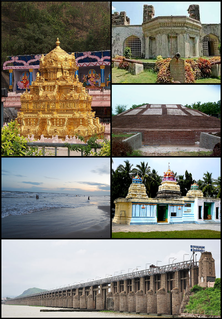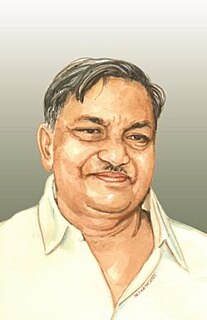Related Research Articles
Kamma is a Hindu caste from South India. The community of Kammas is believed to have originated from agriculturists of the Kammanadu region of the Guntur and Prakasam districts in Andhra Pradesh. Propelled by their military activity in the Vijayanagara Empire, Kammas are believed to have spread out from the region during the Vijayanagara period, followed by some in-migration during the British period and out-migration again during the twentieth century. Today they are regarded as the richest group in Andhra Pradesh and are a dominant caste from Coastal Andhra with socio-economic and political prominence throughout the Telugu-speaking regions of India.

Krishna district is one of the nine districts in the Coastal Andhra region of the Indian state of Andhra Pradesh. Machilipatnam is the administrative headquarters and Vijayawada is the most populated city in the district. It has an area of 8,727 km2 (3,370 sq mi) and had a population of 4,529,009 as per 2011 census of India. It is bounded by West Godavari on the east, Bay of Bengal on the South, Guntur and Suryapet districts in the west and a portion of it also borders with the state of Telangana.

Coastal Andhra is a region in the state of Andhra Pradesh, India. It was part of Madras State before 1953 and Andhra State from 1953 to 1956. According to the 2011 census, it has an area of 95,442 square kilometres (36,850 sq mi) which is 57.99% of the total state area and a population of 34,193,868 which is 69.20% of Andhra Pradesh state population. This area includes the coastal districts of Andhra Pradesh on the Coromandel Coast between the Eastern Ghats and the Bay of Bengal, from the northern border with Odisha to Pulicat lake in the South.

The Pallava dynasty was an Indian dynasty that existed from 275 CE to 897 CE, ruling a portion of southern India. They gained prominence after the eclipse of the Satavahana dynasty, whom the Pallavas served as feudatories.
Krishna is a Hindu deity.

The Satavahanas, Sādavāhana or Sātavāhana, IAST: Sātavāhana), also referred to as the Andhras in the Puranas, were an ancient Indian dynasty based in the Deccan region. Most modern scholars believe that the Satavahana rule began in the late second century BCE and lasted until the early third century CE, although some assign the beginning of their rule to as early as the 3rd century BCE based on the Puranas, but uncorroborated by archaeological evidence. The Satavahana kingdom mainly comprised the present-day Telangana, Andhra Pradesh and Maharashtra. At different times, their rule extended to parts of modern Gujarat, Madhya Pradesh, and Karnataka. The dynasty had different capital cities at different times, including Pratishthana (Paithan) and Amaravati (Dharanikota).

The Reddi kingdom or Kondavidu Reddi kingdom was established in southern India by Prolaya Vema Reddi. The region that was ruled by the Reddi dynasty is now part of modern-day coastal and central Andhra Pradesh. Prolaya Vema Reddi was part of the confederation that started a movement against the invading Turkic armies of the Delhi Sultanate in 1323 and succeeded in repulsing them from Warangal.

Guntur district is one of the nine districts in the Coastal Andhra region of the Indian state of Andhra Pradesh. The administrative seat of the district is located at Guntur, the largest city of the district in terms of area and population. It has a coastline of approximately 100 km (62 mi) on the right bank of Krishna River, that separates it from Krishna district and extends till it empties into the Bay of Bengal. It is bounded on the south by Prakasam district and on the west by the state of Telangana. It has an area of 11,391 km2 (4,398 sq mi) and is the 2nd most populous district in the state, with a population of 4,889,230 as per 2011 census of India.

The Shalankayana dynasty of ancient India ruled a part of Andhra region in India from 300 to 440 CE. Their territory was located between the Godavari and the Krishna rivers. Their capital was located at Vengi, modern Pedavegi near Eluru in West Godavari district of Andhra Pradesh.
The Ikshvaku dynasty ruled in the eastern Krishna River valley of India, from their capital at Vijayapuri during approximately 3rd and 4th centuries CE. The Ikshvakus are also known as the Andhra Ikshvakus or Ikshvakus of Vijayapuri to distinguish them from their legendary namesakes.

Vuyyuru is a town in Krishna district of the Indian state of Andhra Pradesh. It is a Nagar panchayat and the headquarters of Vuyyuru Mandal. It is emerging as neighbourhood of Vijayawada, India situated 28 km away.
Kammanadu is a historical region in the Indian state of Andhra Pradesh. It consisted of parts of the present day Guntur and Prakasam districts.

Challapalli, officially known as Challapalle, is a village in the Krishna district of the Indian state of Andhra Pradesh. It is located in the Challapalli District of the Machilipatnam revenue division. Challapalli is one of the villages in this district, which is part of the Andhra Pradesh Capital Region.

Koti Lingala is a Hindu pilgrimage site in Jagtial district of the Indian state of Telangana. It is situated in Velagatoor mandal of the district, on the Godavari river. It is located on the bank of the Godavari River, and has a traditional Shiva temple for Hindus, the Koteswara Siddeswara Temple.

Andhra Pradesh is one of the 28 states of India whose recorded history begins in the Vedic period. It is mentioned in Sanskrit epics such as Aitareya Brahmana. The Assaka Mahajanapada was an ancient kingdom located between the Godavari and Krishna Rivers in southeastern India.
The Western Ganga Dynasty ruled large parts of southern Karnataka from the fourth century CE till the late tenth century CE with their regal capital initially at Kolar and later at Talakad in Mysore district, Karnataka. The origin of the Ganga clan prior to the fourth century is shrouded in legends and myths. Clarity into their history comes from such contemporaneous writings as Chavundaraya Purana in Kannada and Lokhavibhaga in Prakrit and from numerous inscriptions excavated in the Mysore, Bangalore and Kolar districts and Anantapur district. The Western Gangas played a pivotal role in the development of polity, culture and literature during their long rule in the region, at times as independent monarchs and at other times as subordinates of their larger neighbors: the Badami Chalukyas and later the Rashtrakutas of Manyakheta. Their patronage to literature in Kannada and Sanskrit, their achievements in architecture including the famous monolith of Gomateshwara, their Hindu temples in the southern Karnataka, and their Jain Basadi's of Shravanabelagola and Kambadahalli are testimony to the rich contribution they made to the region.
The Banas were a dynasty of South India, who claimed descent from the asura Mahabali. The dynasty takes its name from Bana, the son of Mahabali. The Banas faced opposition from several neighbouring dynasties and served some major dynasties such as the Cholas and Pandyas as feudatories, sometimes after they were subjugated by them. They also served as Samantas to some dynasties such as Chalukyas. The Banas had their capital at various places at different times, including Kolar and Gudimallam. The earliest mention of the Banas in authentic historical records is in the middle of the fourth century AD, and as the feudatories of the Satavahana and early Pallavas.

Mandali Venkata Krishna Rao, shortly M. V. Krishna Rao, was a politician and minister in Andhra Pradesh, India.

Amaravati is the capital and the de facto seat of government of the Indian state of Andhra Pradesh. The city is located on the banks of river Krishna in Guntur District and the primary city of the state's Capital Region. Built on allotted space on the southern banks of Krishna River in Guntur district selected close to the geographical center of the state.

Rudrasena II (256–278) was a king of the Western Satraps, and the 19th ruler of the Kshatrapa dynasty. The Kshatrapa dynasty seems to have reached a high level of prosperity under his rule.
References
- 1 2 3 P.R.Rao 1993, p. 24.
Bibliography
- P.R.Rao (1993). Ancient and Medieval History of Andhra Pradesh. Sterling publishers pvt. ltd. ISBN 978-81-207-1522-6.CS1 maint: ref=harv (link)
| This biography of a member of an Indian royal house is a stub. You can help Wikipedia by expanding it. |
